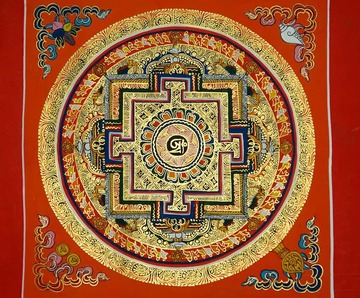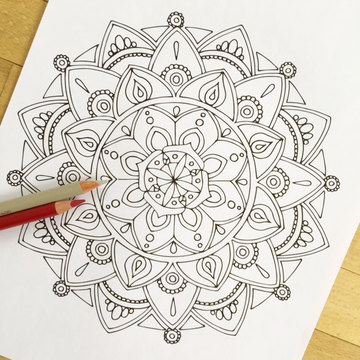Mandalas (pronounced mon-da-las) have had a huge spike of interest over the past couple of years as they have become a popular theme in art recently, however, not many who color these beautiful designs are aware of their strong history and meanings. Mandalas were originally developed for specific spiritual purposes in Asia and later became a more wide-spread tool in various other countries for similar or new purposes.

“Mandala” is the Sanskrit word for ‘circle’
“Mandala” is the Sanskrit word for ‘circle,’ which has so many much significance in many cultures. Circles are known to represent so many things including (but not limited to) nature, balance, cycles, wholeness, eternity, and the universe. These latter three are meanings that are central to the history of mandalas. They often were used in many Asian traditions including Buddhism, Hinduism, Jainism, as well as in Mesoamerican Civilizations, typically in the form of meditations and/or as symbols of worship. They tended to represent a place or person (i.e. a deity) and the outlying symbols surrounding the center would be meaningful to the place or person. The etymology of “mandala” actually implies that “mandala” means “container of essence,” relating to another common representation the universe with the goal of meditating on the mandala in order to become one with the universe. Because of the circular and recurring patterns of mandalas, they create a centering, almost hypnotic, sense within one’s soul when being created, which allows for one to become contained within the shape. This sense of containment is one of the reasons that mandalas are so useful for meditating. The very nature of a circle is perfect for this usage because it is a shape one can get lost in, as it never ends. A circle can be seen in many ways, but also as something that is everlasting.
To push the use of mandalas even further, they are often depicted art forms as telling stories. As mentioned earlier, they can revolve around a place or person, and not only to honor them, but also to tell their story. A mandala can be read starting from the middle, outwards, each layer telling another portion. In this sense, they can surely be used to help one gain an understanding of history, and of themselves. In other words, someone who feels lost might be thinking about ways to find themselves, perhaps through religion, meditation, or therapy. Creating a mandala to tell their story would be a great way to go about finding themselves through all three methods listed above, as mandalas play a role in all three.

The meditative and hypnotic quality that mandalas elucidate in someone as they draw and color them acts like a calming measure
Mandalas within therapy are rooted back to the 1940’s when Carl Jung, a Swiss psychoanalyst, noticed his patients making repetitive circular drawings when utilizing art-making to explore their unconscious. He was familiar with philosophical teachings from India, therefore he coined the term “mandala” to apply to these drawings of his patients. With that, mandalas became a regularly used tool in the psychology field. Even now, mandalas are being utilized majorly in the art therapy field. With this in mind, it is no surprise that mandalas are used in coloring books. The meditative and hypnotic quality that mandalas elucidate in someone as they draw and color them acts like a calming measure. Coloring books have become a huge market today, with mandala specific books at the top of the charts.
While in today’s time, we simply create mandalas with some paper and a drawing utensil, back in the early days, creating mandalas was no easy task. A minimum of four monks would work for days, weeks, even months, to paint a mandala. Each monk would work on a particular quadrant beginning from the very center of the allotted space. While working, the monks ensured to keep the balance as they worked by painting and carving in tandem with one another on each section, only moving outwards when everyone else was also ready to do so. From the very beginning of its creation, every mandala is loaded with strength and reverence. Mandalas are special entities that are beautiful and powerful at the same time.
Knowing the origin of these meaningful designs helps to create an understanding of why they are so used and how that can help people. Being ignorant of their background inhibits the fruitful benefits they can yield within one’s life.




